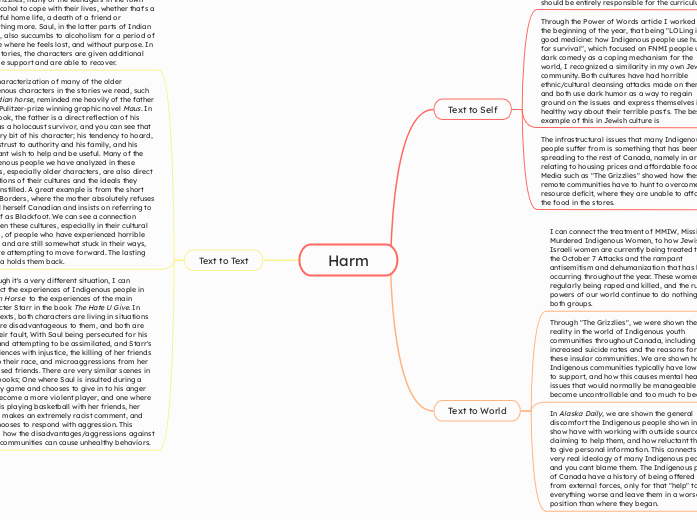Harm
Text to Self
I can easily connect the harm that has been done to the indigenous people, mainly by the Canadian government, to the simliar struggles of the Jewish people in my community. Throughout this year, my community has experienced a profound amount of ignorance for our needs and protection from the Canadian government, similar to what the Indigenous Canadians have been experiencing for years. It really makes me think that the Canadian government should not be responsible for the content of this course, and that indigenous leaders should be entirely responsible for the curriculum.
Through the Power of Words article I worked on at the beginning of the year, that being "LOLing is good medicine: how Indigenous people use humor for survival", which focused on FNMI people using dark comedy as a coping mechanism for the world, I recognized a similarity in my own Jewish community. Both cultures have had horrible ethnic/cultural cleansing attacks made on them, and both use dark humor as a way to regain ground on the issues and express themselves in a healthy way about their terrible past's. The best example of this in Jewish culture is
The infrastructural issues that many Indigenous people suffer from is something that has been spreading to the rest of Canada, namely in areas relating to housing prices and affordable food. Media such as "The Grizzlies" showed how these remote communities have to hunt to overcome this resource deficit, where they are unable to afford the food in the stores.
Text to World
I can connect the treatment of MMIW, Missing and Murdered Indigenous Women, to how Jewish and Israeli women are currently being treated through the October 7 Attacks and the rampant antisemitism and dehumanization that has been occurring throughout the year. These women are regularly being raped and killed, and the ruling powers of our world continue to do nothing for both groups.
Through "The Grizzlies", we were shown the true reality in the world of Indigenous youth communities throughout Canada, including the increased suicide rates and the reasons for them in these insular communities. We are shown how Indigenous communities typically have low access to support, and how this causes mental health issues that would normally be manageable to become uncontrollable and too much to bear.
In Alaska Daily, we are shown the general discomfort the Indigenous people shown in the show have with working with outside sources claiming to help them, and how reluctant they are to give personal information. This connects to the very real ideology of many Indigenous people, and you cant blame them. The Indigenous people of Canada have a history of being offered help from external forces, only for that "help" to make everything worse and leave them in a worse position than where they began.
Text to Text
"Indian Horse" And "The Grizzlies" have an easy connection to make through some of the character's common struggle with Alcoholism. In The Grizzlies, many of the teenagers in the town use alcohol to cope with their lives, whether that's a stressful home life, a death of a friend or something more. Saul, in the latter parts of Indian Horse, also succumbs to alcoholism for a period of his life where he feels lost, and without purpose. In both stories, the characters are given additional outside support and are able to recover.
The characterization of many of the older indigenous characters in the stories we read, such as Indian horse, reminded me heavily of the father from Pulitzer-prize winning graphic novel Maus. In this book, the father is a direct reflection of his past as a holocaust survivor, and you can see that in every bit of his character; his tendency to hoard, his distrust to authority and his family, and his constant wish to help and be useful. Many of the Indigenous people we have analyzed in these stories, especially older characters, are also direct reflections of their cultures and the ideals they have instilled. A great example is from the short story Borders, where the mother absolutely refuses to call herself Canadian and insists on referring to herself as Blackfoot. We can see a connection between these cultures, especially in their cultural elders, of people who have experienced horrible things and are still somewhat stuck in their ways, despite attempting to move forward. The lasting trauma holds them back.
Although it's a very different situation, I can connect the experiences of Indigenous people in Indian Horse to the experiences of the main character Starr in the book The Hate U Give. In both texts, both characters are living in situations that are disadvantageous to them, and both are not their fault, With Saul being persecuted for his race and attempting to be assimilated, and Starr's experiences with injustice, the killing of her friends due to their race, and microaggressions from her supposed friends. There are very similar scenes in both books; One where Saul is insulted during a hockey game and chooses to give in to his anger and become a more violent player, and one where Starr is playing basketball with her friends, her friend makes an extremely racist comment, and she chooses to respond with aggression. This shows how the disadvantages/aggressions against these communities can cause unhealthy behaviors.
